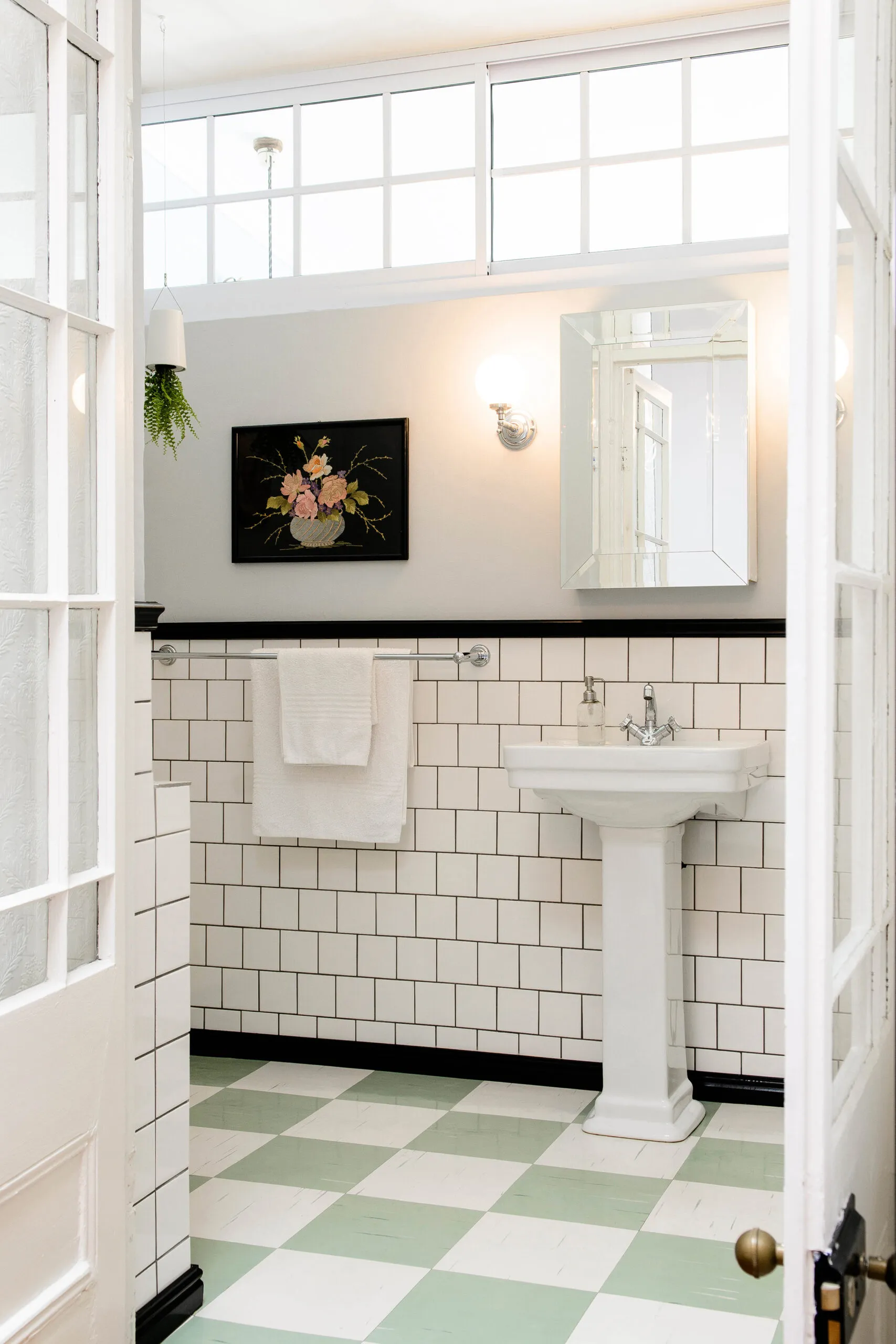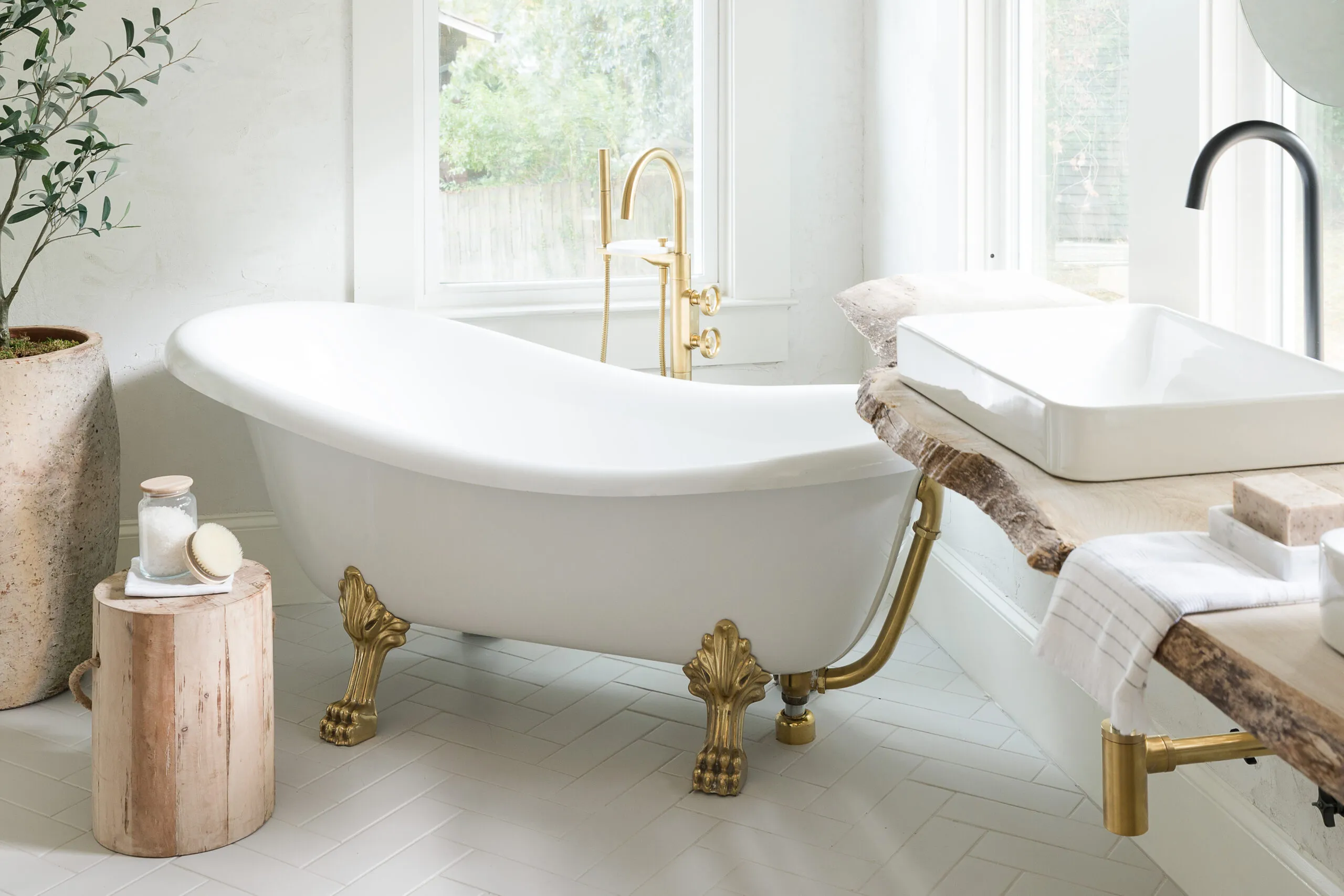A bathroom renovation can be costly, but updating your flooring doesn’t have to break the bank. There are several inexpensive bathroom flooring options (under $5 per square foot) available that look high-end. In this article, we’ll explore six of them, including their benefits and drawbacks, cost, and how to take care of them.
1. Standard Vinyl Flooring
Cost: $1–$2 per square foot
Vinyl flooring is the most popular option for a budget-friendly bathroom because it’s resilient, easy to install, and highly resistant to water damage.
Peel-and-stick vinyl flooring is available in an endless array of shapes and styles, allowing you to achieve almost any look you want. Sheet vinyl offers seamless coverage that provides superior water resistance. Both options are easy to clean and maintain.
*All cost data is based on current pricing at big-box hardware stores.
2. Luxury Vinyl Flooring (LVF)
Cost: $3–$10 per square foot
Luxury vinyl flooring is a bit more expensive than standard vinyl but a lot more durable. It’s thicker and more rigid than regular vinyl, and it’s assembled using a locking tongue-and-groove system, making it relatively easy to install.
LVF is available in a wide range of creative patterns, including faux wood and stone designs, allowing you to achieve a high-end look at a fraction of the cost.
3. Linoleum Flooring

Cost: $3–$12 per square foot
Linoleum is a naturally composed material that has regained popularity in recent years due to its renewable and eco-friendly nature. While linoleum is resistant to moisture, it does require periodic sealing to protect against water penetration.
Linoleum comes in various colors and patterns, though not as varied as vinyl or laminate. It does well in colder climates as the thicker material provides insulation. The initial cost may be slightly higher than some other budget options, but its longevity can make it cost-effective long term.
4. Laminate Flooring
Cost: $1–$5 per square foot
If you’re looking to achieve the natural look of real wood in your bathroom without the hefty price tag, laminate flooring is an excellent alternative. Laminate flooring is made from wood byproducts. Thick laminate planks have several layers that make them strong, waterproof, and warp-resistant.
You can find laminate that looks like hardwood, stone, or even ceramic tile, allowing you to achieve your desired look at a fraction of the cost. Laminate is also relatively easy to install, making it a popular choice for DIY enthusiasts. When choosing laminate for your bathroom, be sure to select a product specifically designed for high-moisture areas to ensure longevity and performance.
5. Ceramic Tiles
Cost: $4–$15 per square foot
While some high-end ceramic tiles can be expensive, there are basic, standard stock versions available at an affordable price. This makes ceramic tiles an excellent option for those seeking an elegant look without breaking the bank.
One of the biggest advantages of ceramic tiles is their extreme water resistance. They’re also long-lasting and easy to clean, and they come in a wide variety of designs, colors, and patterns.
6. Concrete

Cost: $4–$8 per square foot
Concrete can be polished to create a cool, sleek appearance. It does require proper sealing to prevent water from seeping into its pores. However, when protected correctly, it performs exceptionally well in wet environments.
One of the biggest advantages of concrete flooring is its seamless, groove-free surface, which makes it incredibly easy to clean and maintain. Concrete can also be stained or painted to achieve different looks, allowing you to customize your bathroom floor to match your desired aesthetic.
What To Look for in Bathroom Flooring
When selecting affordable bathroom flooring, consider the following:
- Water resistance: The flooring must be able to withstand moisture and occasional spills.
- Durability: Look for materials that can handle frequent use and cleaning.
- Ease of installation: Consider whether you can install the flooring yourself to save on labor costs.
- Maintenance requirements: Choose flooring that’s easy to clean and maintain.
- Style: Your flooring should match or complement your bathroom’s overall design.
Maintenance and Care for Bathroom Flooring
Proper maintenance is key to ensuring the longevity of your bathroom flooring. Here are some general tips for caring for your new floor:
- Clean spills immediately to prevent water damage or staining.
- Use a damp mop or cloth for regular cleaning, avoiding excess water.
- Avoid harsh chemical cleaners that could damage the flooring material.
- For vinyl and laminate, use manufacturer-recommended cleaning products.
- Reseal concrete and linoleum floors periodically to maintain water resistance.
Our Conclusion
There are plenty of affordable bathroom flooring options that don’t skimp on quality. Remember to consider factors like water resistance, durability, and ease of maintenance when choosing the right type for your project.

